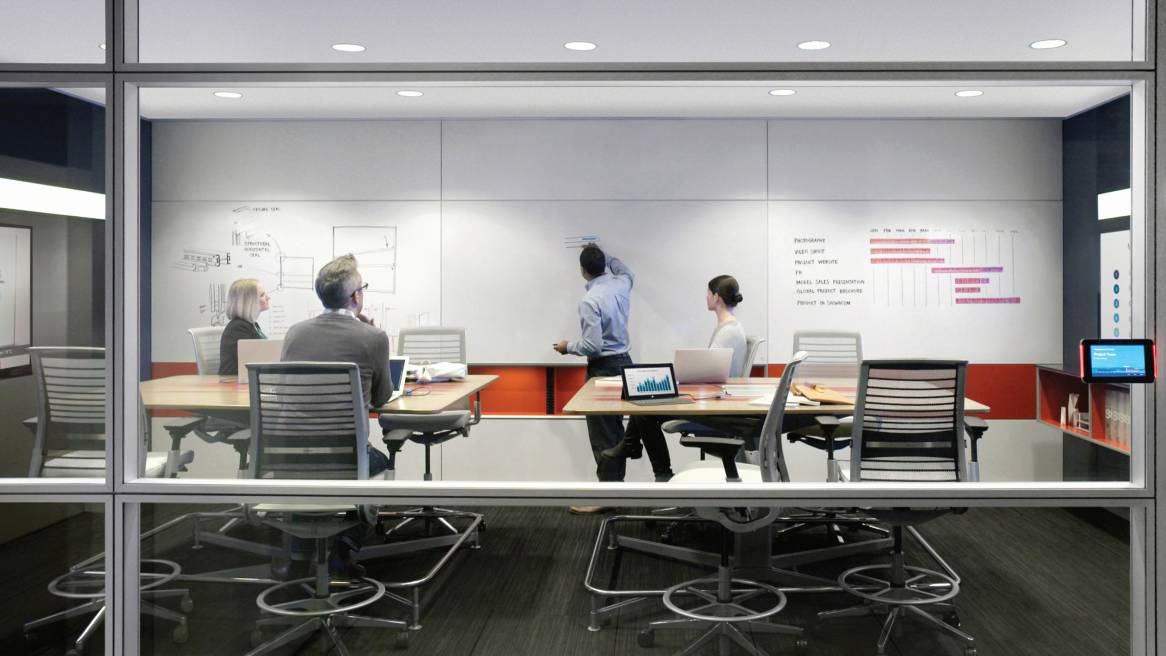How Place Fosters Innovation
Today nearly everyone agrees that innovation is the only way to supercharge an organization and shift it to growth.
Nearly everyone agrees that innovation is the way to supercharge an organization to growth. The right places can help make it happen.
Innovation is the “secret sauce” of business success, according to Harvard Business Review.1 Consulting giant McKinsey says that a company’s ability to innovate has become “the core driver of growth, performance, and valuation.”2
Today nearly everyone agrees that innovation is the only way to supercharge an organization and shift it to growth.
The ability to see new opportunities and harness resources to pursue them is a fundamental advantage for any organization, from super corporations to start-ups.
But many are uncertain about just how to make innovation happen, especially when the pressure to stay skinny and do more with less remains strong. Management wants to get the most out of every effort and avoid dead-ends, and by definition innovation is never a sure thing. At the same time, thanks to advances in the social sciences and the growing influence of design thinking as a problem- solving methodology, more knowledge is available than ever before about how to incubate innovation and assure it flourishes.3
Although innovation remains an often messy and usually nonlinear process, deep investigation is pointing to emerging strategies for success. Of course, human creativity has always been and still remains the bedrock of innovation. But the myth of the lone genius achieving one eureka after another in a closed room is a cartoonish, outdated cliché. There’s growing understanding that real breakthrough comes from people doing the hard work of innovation together, mixing their ideas in a bouillabaisse of insights and laddered thinking. People really do need people — to deepen the pool of possibilities, to wade through the snarl of complexities, to achieve the multifaceted clarity of brilliant solutions. Happily, together is exactly the way Generation Y prefers to work, and their pervasive influence on knowledge work is being embraced by workers of all generations, creating a whole new set of requirements for companies that want to compete and lead.4
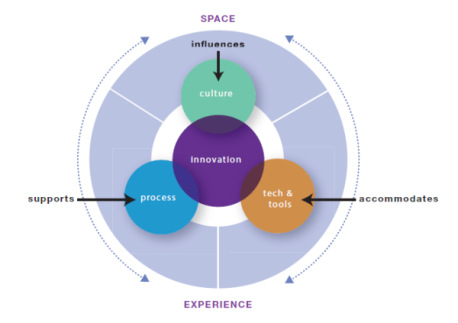
When it comes to the need for innovation, it comes down to two words: more and faster.
No wonder successful organizations look for every way possible to help their creative, collaborative thinkers be as productive and high- performing as possible. Business leaders are ready to invest in resources and implement methods that can up an organization’s capacity to innovate.
Harder-working, next- generation workspaces are a sometimes-overlooked but key element for reaching that Holy Grail of today. The right kinds of spaces can help people collaborate, share knowledge, learn together, and build the social networks of trustful interaction that are so critical for solving big challenges. As noted author and expert John Seely Brown has concluded, the cultures that constantly produce innovation have visionary leadership, an organizational commitment to breakthrough thinking, and a place that supports the work of innovation.5
By closely observing innovation in action in various organizations, Steelcase researchers have identified several critical components in the emerging science of innovation. Space is the stage for the overall experience and, as such, it needs to work hard on all fronts: supporting the business processes, positively influencing the culture, and fully accommodating the appropriate technology and tools. When seamlessly integrated, these components comprise a multi-dimensional “surround sound” that supports successful innovations, one after another.
Because of the symbiotic relationship of all these components, done right the workspace can both inspire and facilitate innovation. And that’s more important today than ever. A nine-month study of U.S. companies conducted by Steelcase shows that Gen Y’s new behaviors and workstyles are driving new, dramatic shifts in knowledge work and the workplace. Moreover, these shifts are being embraced rapidly by workers of all generations.6 Complementing this groundswell from the rank- and-fi le who expect they’ll be able to be creative at work is the conviction among their leaders that, when it comes to the need for innovation, two words say it all: more and faster. This paper focuses on the findings of secondary and primary research on innovation conducted by Steelcase, which included a survey of more than 200 corporate real estate practitioners that was co-sponsored with CoreNet Global and observation studies with clients that helped to identify innovation behaviors and processes in actual work settings. Adopting methodologies from anthropology and other social sciences, Steelcase’s Applied Research Consultants and WorkSpace Futures teams, in collaboration with architects, designers and corporations worldwide, are discovering new insights into the types of spaces that work hardest to support meaningful interactions, foster collaboration, and deliver on innovation.
This ongoing research has identified specific variables that affect how organizations approach innovation. From different combinations of these attributes, the Steelcase researchers identified eight different structural models of innovation within organizations. Each model has its own space implications, which are discussed and illustrated. Steelcase continues to research how the design and use of worksettings can strengthen a company’s posture for innovation, with plans to incorporate key findings in its own new innovation center scheduled to open in 2012.
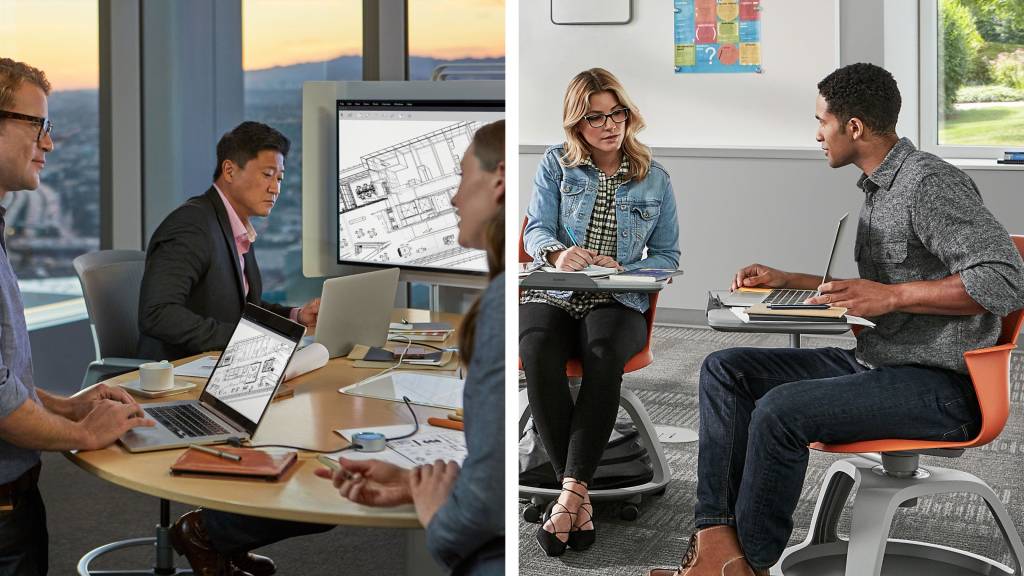
MAKING ROOM FOR INNOVATION
The Steelcase/CoreNet Global survey findings suggest that innovation processes are established within most organizations. Only 9% of respondents said innovation wasn’t at all important or only somewhat important to their organization. For most (82%), business strategy is closely tied to innovation.
Over half of the respondents (55%) said they often bring people with diverse backgrounds together to work on innovation projects. A strong majority of organizations (85%) partner with outside consultants or experts to help with innovation, usually for occasional projects (67%) versus most or all projects, and two-thirds have long-term relationships with external resources.
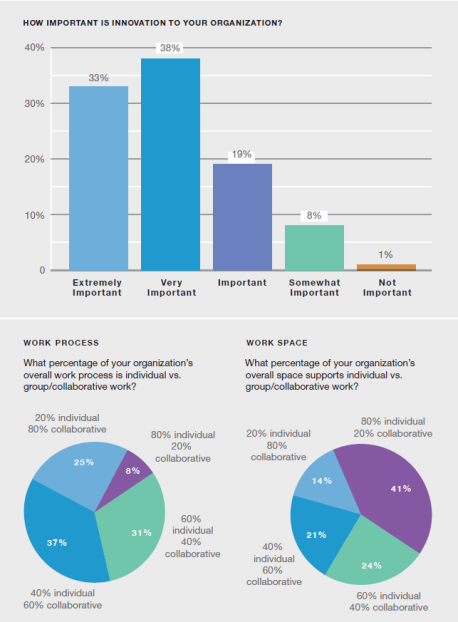
The survey results indicate, however, that workplace strategies may not be keeping pace with organizations’ innovation processes and ambitions. Specifically, 75% say the responsibility for innovation is spread throughout their organization versus residing within a focused team or department, and 60% say their organization’s overall work process is more collaborative than individual. When asked if their organization has spaces that support the innovation process or groups of people that are working on innovation projects, 69% answered yes. Yet, 65% say that most of their overall space supports individual versus collaborative work, revealing an impeding disconnect between intent and reality, or possibly misperceptions about what kind of spaces actually support innovation. An individual work area can’t support innovation easily, and a traditional conference room won’t either.
With innovation so important to overall strategy and organizational success, providing the right spaces to support it can fully unlock possibilities, propelling both processes and people to faster, stronger innovations.
SMALL STEPS, BIG LEAPS
There are many ways to categorize and describe the process of innovation. One sure evidence is the plethora of books on the topic that have been published in recent years, pointing to a strong desire among researchers and readers to get their heads and arms around a deeper understanding of what innovation really is. Many experts simplify the topic by putting innovation into two major categories: sustaining innovation and disruptive innovation, a term popularized by Clayton M. Christensen, a Harvard Business School professor who authored The Innovator’s Dilemma, which has since become recognized as a classic examination of the danger of placing too much emphasis on satisfying customers’ current needs instead of their unstated or future needs.7
Sustaining innovation is an improvement made to something that already exists. For example, today’s cell phone innovations have made the existing technology smaller, better, faster,and increasingly more multipurpose. Disruptive innovation is a true breakthrough that creates a new product or service category, or even a whole new market — retail medical clinics, for example, disrupting the established market for doctor’s services. Companies need both disruptive and sustaining innovation to become and stay leaders.
Sustaining innovation satisfies customer needs, sells for higher margins, and may offer a competitive edge. Disruptive innovation ensures competitive advantages, often for a longer period of time, and builds momentum inside the organization and in the marketplace.
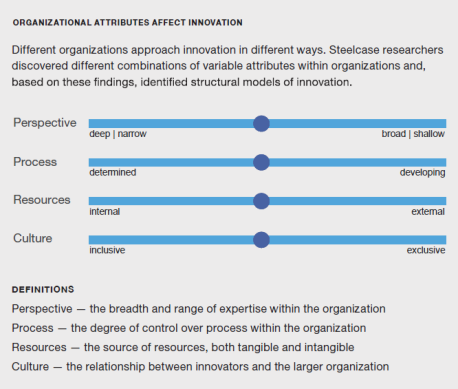
The Steelcase/CoreNet Global survey showed that 33% of organizations believe that 40-60% of their innovations are sustaining, and half less than 20% of their innovations are breakthroughs. If an organization pursues only sustaining innovations that perpetuate what has historically caused them to succeed, they unwittingly open the door to disruptive innovations by competitors that can overtake the market or make it obsolete. For example, Apple’s iPod was an innovation that disrupted business-as- usual within the recording industry just as community colleges, with their emphasis on gaining fast-track, vocation-specific skills, upset the comfortable status quo of four-year colleges.
DIFFERENT STROKES
Why do some organizations approach innovation differently than others? When it comes to its structure of innovation, each organization is distinguished by key attributes or variables across a range of options (see diagram above.) Any single attribute can be “dialed up or down.” In combination, they can define different ways of approaching innovation.
MODELS OF INNOVATION

By analyzing different combinations of attributes within different organizations, Steelcase researchers have identified eight models of innovation that support both sustaining and disruptive innovation. The placement of the eight on a spectrum shows the degree to which the innovation efforts are centralized or decentralized. Some organizations look inward; others look externally for fresh ideas and new ways of solving problems.
Some organizations use just one depending on the type of project and the desired outcome.
Each model has its own implications for the type of space that will best support the organization’s efforts to hatch, incubate, and develop new ideas. Here is a description of each model.
1) IN-HOUSE MARKETPLACE MODEL
In this highly centralized model, a culture of innovation and concept development is enmeshed at every level of the organization. There’s heavy cross-pollination of ideas, and each team and every person is responsible for innovation. Digital wireless communications giant Qualcomm is a good example of this model with their internal message, “Whatever it is you do, our pathway to innovation begins and ends with you.”
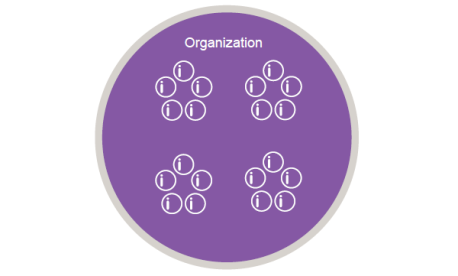
Space that works: It’s important to create neighborhoods where each team can collaborate and share ideas. A central project area allows information to be posted on walls or other vertical surfaces for quick visual updates. Private areas support deep discussions or brainstorming without interruptions. The café is a spot to chat it up, serving as both a boundary between teams and an attractor for people from other areas to come over and mingle ideas.
2) IN-HOUSE SHARE MODEL
In this resource-sharing model, members of multiple specialized groups can align easily on an as-needed basis. Team members can depend on immediate assistance from each other due to proximity, and the space supports a shared culture among groups that interact together almost continuously on both long- and short-term projects.
This is the model used at Steelcase to align the research and development WorkSpace Futures team with product development and service teams.
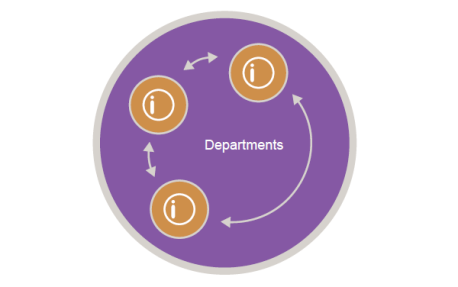
Space that works: Each team has a front porch where public information can be shared. Deeper into the space, more information is revealed. Private areas for each team allow them to risk new ideas and work through prototypes without the distracting scrutiny of outsiders. Enclosed project areas are flexible so the team can expand and contract as needed. Individual workspaces are on the peripheries of adjacent areas.
3) IN-HOUSE CENTER MODEL
This model of innovation empowers a distinct group that’s responsible for innovation within the organization. This special team, which has deep industry expertise, typically employs atypical processes yet remains part of the larger culture and relies on easy access to organizational resources. Mayo Clinic, with its first-of-a-kind SPARC Innovation Program, is an example of this model of an organization that makes the innovation process and facility a distinct yet integral part of the larger culture.

Space that works: The team needs a neighborhood for their work that’s linked to an oasis at the center where they can chill out and chat. Project spaces are also linked to the oasis, which is big enough for sharing ideas and prototypes among team members. A prototyping area creates a boundary that allows the outside to look in as ideas are tested and mocked-up in real space.
4) OFFSITE MODEL
For some organizations, getting away is how innovation happens best. In this model, a remote center is where a team develops, prototypes, and validates innovation initiatives. The team has a unique culture and the freedom to pursue distinct values and processes. At the same time, access to organizational resources is a given.
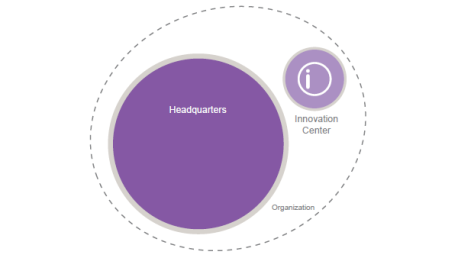
Space that works: Keeping in touch with “the mother ship” is key for any off-site group, so videoconferencing capabilities are especially important. As a self-contained offsite, a welcoming “front porch” zone allows the team to host visitors. A boundary of enclaves provides space for both private and public meetings. Deeper inside are areas for the guts of innovation: labs, project spaces and prototype zones, as well as alternative worksettings for mobile team members.
5) PARTNERSHIP MODEL
Sometimes a melding of perspectives is the fastest way to breakthrough. Via longor short-term alliances, organizations purposefully leverage diverse competencies, gain access to distinct resources, transfer knowledge, and share risk and cost. That’s why Apple and Nike have teamed up to collaborate on products such as the running shoe Moire that includes a sensor working with an iPod to provide verbal information about distance and speed, as well as music that goes the distance.
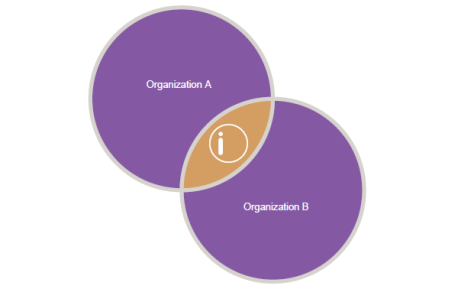
Space that works: Mine, yours, and ours. In this model, each partner has its own space, and they share space too — physically as well as virtually. Alpha collaboration and testing happens in shared real estate, then each goes back to their own turf to consult with expert resources and work in specialized labs until they’re ready to come together again. Touchdown spaces and presentation areas happen in all three spaces.
6) CONSULTANCY MODEL
Think of this as innovation experts doing a house call by coming into an organization on a project basis. They bring with them a distinct problem-solving skill set and a fresh perspective that’s unencumbered by real or perceived organizational baggage. They leave behind lasting education on the hows of innovation that can transform many projects-to- come. Procter and Gamble is just one organization that has worked with IDEO, the consultancy company, in this model.
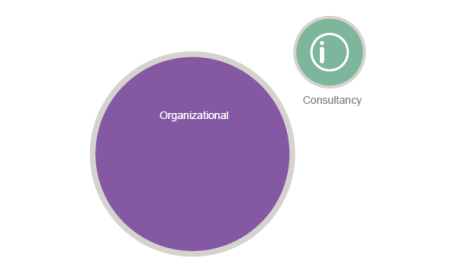
Space that works: They may have very different cultures, but shared space allows them to come together to share information that needs to be supported in both arenas. Typically, this happens in a “guest house” space at the host site. Here’s where both organizations share ideas, test prototypes, and push for innovation in neutral space that includes project zones, social spaces, and resource areas. Meanwhile, each has the backdrop of their separate sites where individual culture prevails.
7) THE NETWORK MODEL
“If you build it, they will come” is the attitude behind this innovation model which invites people to visit and bring their ideas with them, joining a company- managed network that typically includes institutions, organizations, community members, or practitioners — or all of the above. The input process is random to allow for the breadth of perspectives and unexpected outcomes that come from self-selected contributors who have a personal motivation to participate. Lego’s Design by Me website does just that, and it’s where Lego gets some of its best ideas for new kits.
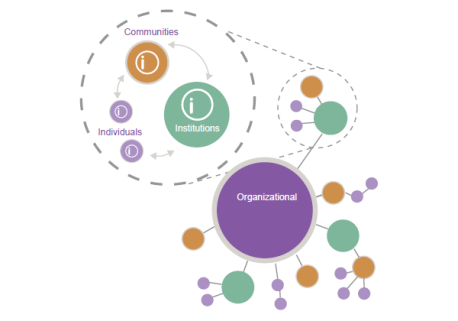
Space that works: Various types of hosting events — offsite or online —allow people to come together and share information that’s then taken back into a team neighborhood within the organization for further exploration and refinement.
8) THE COMMUNITY MODEL
It’s all about the need of now, as an autonomous network comes together to contribute ideas and potentially solve a need quickly together. The advantages are a breadth of perspective that’s independent of any organization combined with a free and open transfer of knowledge.
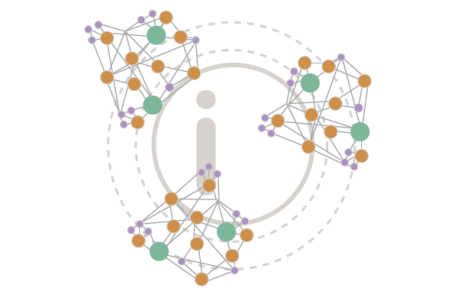
Space that works: Although heavily technology-dependent, the community model can also benefit from spaces that bring disparate people together and support the work they want to do. By-reservation or membership spaces for today’s “co-working culture” (practicing alternative work strategies or self-employed) are laboratories to study the growing phenomenon. Initial findings suggest that a social lounge area is a welcome addition to the predictable fare of spaces for individual work and meeting rooms. A gallery for art displays or presentation space is another way to make the space less impersonal and more collaborative.
DESIGNING FOR INNOVATION
Whichever model of innovation an organization employs, the design of the space is an important driver that can improve the speed and outcomes of innovation efforts. Successful design can significantly remove barriers and support the work of the talented people that organizations rely upon to improve their innovation performance. Simply stated, the right spaces make innovation work.
Here are some principles to consider when designing spaces for innovation activities:
Make the space flexible
Innovation spaces need to be reconfigurable to support spontaneity: switches between different work modes, the dynamic flow of information, tools that come and go. In addition, organizations may require use of the space by multiple project teams, simultaneously or in sequence, which makes flexibility all the more important.
- Consider a mix of fixed and fluid architectural elements — i.e., semi-permanent walls and movable partitions
- Create a flexible hub for large and small group activities
- Provide for user configurability with mobile furniture
- Consider privacy issues by providing enclosed spaces for audio and videoconferencing
Make the space inspiring
Creating something new is fundamental to all knowledge work, and inspiration is especially important for those charged with product and service development and other areas of organizational innovation. Stimulating, engaging spaces can jump-start and sustain creative thinking.
- Provide for abundant natural lighting and views
- Include natural elements and materials throughout the space
- Consider color carefully in terms of its ability to excite or sooth
- Provide settings that are casual, informal, and comfortable
Allow for artwork and meaningful objects throughout the space that can support individuals and culture.
Make the space collaborative
Innovation teams require a shared mind. Individual insights and memory need to become group learning and memory — the sooner, the better — and the history of the project needs to be readily discernable to reduce unnecessary backtracking and errors.
- Position individual workspaces around group spaces to maximize visibility
- Provide group areas for informal brainstorming and informal information swaps
- Plan for extensive dialogue with digital information and intense collaborations around computers that can involve both collocated and virtual team members
- Provide for vertical content displays with whiteboards, tackable surfaces, foam core boards, projection surfaces, etc., that allow users to actively affect and engage with information
Make the space a hard-working tool
Hard-working spaces can be just as much of a tool as anything else a team uses to innovate. By supporting all the modes of work — focusing, collaborating, learning, and socializing — every square foot of an innovation space can become an efficient workshop for new ideas.
- Consider the wall architecture as a way to organize and display information in a way that links to group processes
- Make sure active and stored work tools are easily accessible
- Think of every vertical surface in terms of its potential for information displays
- Consider layered storage that can serve double-duty by keeping materials handy and defining zones
- Provide a responsive infrastructure that supports technologies
Make the space a reflection of culture and brand
An organization’s identity and culture provide reassuring context and meaning to innovators, and space can be a way to authentically underscore important values and processes. Reflecting brand and culture within a space is a way that design can underscore organizational support for innovation.
- Reinforce tone and culture authentically in the design of the space, recognizing that what works for one organization doesn’t automatically work for another
- Allow for displays of products and other collective achievements that will inspire pride and risk-taking
- Allow for team customization and personalization to reflect ownership and identification
Make the space social
Social capital between co-creators is crucial for innovation to occur. It builds trust, especially important when teams are doing intense work. Open and relaxed areas for informal conversations are critical components for successful innovation spaces.
- Provide convenient access to food and beverages
- Provide comfortable lounge seating, café tables, and other furniture that invites mingling
- Locate casual collaboration areas in close proximity to work areas so it’s easy to take a break, swap stories, etc.
- Provide welcoming areas for guests with appropriate views into the space and work in progress
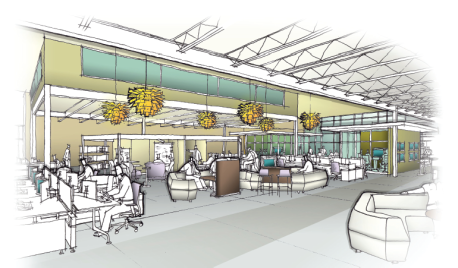
INNOVATING THE WORKPLACE FOR INNOVATION
Everyone wants more innovation, yet organizations define it differently in the context of their business processes, culture, technology, and tools. Supporting and aligning all these components can cause innovation to flourish, often in unforeseen ways within all the patterns of innovation.
Space provides places for people — both from within and outside an organization — to come together and invent new solutions for both ordinary and extraordinary challenges. As a result, design is emerging as an innovation imperative as it continues to show how hard-working spaces can reinforce and align the other organizational components that contribute to a company’s ability to invent new solutions.
As organizations work to become or remain relevant and meaningful, rethinking the workplace can support, inspire and enable innovation. In so doing, it can make a significant contribution to any organization’s current posture and future potential for success.
One square foot at a time, more and faster innovation is within every organization’s reach.
ACKNOWLEDGEMENTS
Steelcase conducts ongoing research on work and the workplace, and this research forms the basis of our perspective on innovation in the workplace. We are especially thankful to our colleagues in the real estate and design communities who share their insights and experience with us. Several individuals contributed thoughtful perspective on these issues and helped shape our insights. Our sincere thanks to:
Tim Brown, IDEO
Bethany Davis, Nokia
Josey Duke, Accenture
Dan Johnson, Accenture
Jan-Peter Kastelein, YNNO
Lauri Lampson, Planning Design Research
Roger Martin, University of Toronto CoreNet Global
ENDNOTES
1 Harvard Business Review, March 2010
2 McKinsey Quarterly, Article 2008-12-12
3 Noteworthy books on innovation include:
The Sticking Point Solution: 9 Ways to Move Your Business from Stagnation to Stunning Growth In Tough Economic Times by Jay Abraham
Change by Design by Tim Brown The Innovator’s Dilemma by Clayton M. Christensen
The Power of Pull: How Small Moves, Smartly Made, Can Set Big Things in Motion by John Hagel III, John Seely Brown, and Lang Davison
The Design of Business by Roger Martin
The Leader’s Guide to Lateral Thinking Skills: Unlocking the Creativity in You and Your Team by Paul Sloane
4 Steelcase 360 Magazine, August, 2009
5 Seeing Differently: Insights on Innovation, John Seely Brown, Harvard Business Review book series, 1997
6 Steelcase 360 Magazine, August, 2009
7 The Innovator’s Dilemma, Clayton M. Christensen, Harvard Business School Press, 1997

